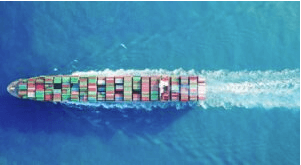Even if a shipper works with a freight forwarder, the fact is that shipping lines are an essential cog in the wheel of ocean transportation. Shipping lines provide the critical service of transporting cargo from port to port, which facilitates global trade.
Many BCOs (Beneficial Cargo Owner) have considered and tried, at least once, to cut out the OTI (Ocean Transport Intermediary). They consider them to be a middleman. The general view is that going directly to the shipping lines will result in better service and lower price.
Shippers have also found out that working directly with shipping lines may not always be the best option. Shipping lines typically prefer to work with big volume shippers. These customers can give them a base load for their massive operation.
Small and medium size BCOs or, in some cases, even large corporations with complex logistics needs may not get what they want in terms of rates and services directly from a shipping line. It is because shipping lines do not perform all the functions that an OTI does.
Nevertheless, maintaining a good relationship with shipping lines and keeping the best of them as partners is essential for all operations. Regardless if the shipper works directly with them or collaborates with an OTI who manages these relationships for them.
Tips for Keeping Your Best Shipping Line:
The relationship between a shipper and shipping line may at times become a delicate dance between the shipper’s best interests and the sometimes-competing interests of the shipping line.
A long term healthy relationship between a shipper and shipping line will, in the long run, become a major dynamic for both parties and can be considered as a competitive advantage for both.
But, there is a problem. In this era of consolidation, mergers, and acquisitions, it seems quite difficult to select and stick to a good and reliable shipping line that can satisfy your requirements.
While no one likes and wants a change, reliable shipping lines with excellent service coverage are more and more hard to come by.
Alliances
April 1, 2017, saw the launch of three alliances: 2M, Ocean Alliance, and THE Alliance. They control container trading mainly on the Trans-Pacific and a major part of Asia-Europe.
These three alliances cover 11 lines (all ten from the Top 10 container lines + 1 from outside the Top 10) and collectively account for about 71% of the global container market share leaving only 29% for the other lines.
So, if you take any of these alliances as an example, the cooperating carriers will offer the same routes, same port pairs, same transit time, same types of containers (some may not offer special equipment), same delays when there are delays, more or less the similar rates.
So how do you manage to keep the good shipping lines?
For starters, IDENTIFY who you can consider being a good shipping line. Some of the characteristics could be:
- Don’t look at price alone. If a shipping line’s rates are like a yo-yo, the chances are that their service will not be stable for long.
- Consider the background and stability of the shipping line. Check how long the shipping line has been around if they have their own offices, infrastructure, and assets.
- Identify their strengths and whether those strengths complement your service offering to your clients. You cannot provide an efficient service to your client if the shipping line you choose doesn’t have the strength of service.
- Employees are great ambassadors of a company. So knowing how long the staff has been with the shipping line and how they interact with customers will give you a fair indication of how the shipping line will treat you as a customer.
- Service is also an indicator of which shipping line you want to keep. It is important since the service you receive will be the cornerstone of your service to your customer.
So, you have identified the shipping lines but how do you keep the shipping lines that you want with you?
Easier said than done in this tough environment, but here are a few ways to keep the best shipping lines.
Show Loyalty
Loyalty is an essential ingredient in the relationship. Many shipping lines lose customers on a regular basis due to disloyal customers who jump ship for a 10 dollar reduction in freight.
Customers need to understand that they need the shipping lines just as much as the shipping lines need them.
Customer loyalty is one of the best ways in which the clients can maintain the relationship with the shipping line and keep them in times of need.
Loyalty from the side of the customer is usually reciprocated by the shipping line. Shipping lines will do their best to avoid roll-overs, drastic rate increases for their loyal customers while also adding some perks like extra free time etc.
Develop a Partnership
Partnership in any business is something that should be valued by both the customer and the shipping line. A good partnership only serves to strengthen your business and allows you to focus on your core competencies.
It is important to understand that a shipping line works with you and not for you and therefore it will be beneficial for you to treat them as a partner.
The selection, cultivation, and building of a partnership with your shipping line should be a constant process. It balances your business needs with the needs of your customer as well.
Partnering with shipping lines and developing deep, mutually beneficial relationships over the long-term is a means by which you can strengthen your service offering to your client, lessen your risk and develop true supply chain excellence.
Have mutual respect
Any solid relationship is built on mutual respect and a relationship between a shipper and shipping line is no different.
A shipper must appreciate the workings and capabilities of a shipping line as much as they expect the shipping line to understand their requirements and cater to the same.
By taking the time to develop trust, confidence, and a sense of mutual respect with the shipping lines that you have decided to work with, you can create a goodwill that will stand you in good stead in times of need in your business.
Be Credible
A lot of the shipping lines are willing and do sacrifice some percentage of their earnings to secure some base cargo through short-term or long-term service contracts.
They need these contracts to optimize the slot utilization on their ships, and for this, they are dependent on the shippers.
Credibility is essential in your partnership with the shipping lines. It is important for you to display it consistently, so the shipping line also reciprocates the same.
Here credibility is equated to promise or the customer’s word. For example, if the shipper commits to an MQC (Minimum Quantity Commitment), the shipping lines will provide guaranteed space and rates to the client to help the client achieve their MQC.
If you as the shipper are aware of some factors that may prevent you from making the MQC you need to communicate that with the shipping line. So they can make alternate arrangements to protect their interests.
Behave Ethically
Ethics plays an essential part in the relationship between a shipper and shipping line. There are many cases all over the world where the shippers use some of the shipping lines purely to benchmark freight rates, squeeze the shipping lines for cheap rates based on their volumes, only to take that rate and go to their line of choice and ask them to match these rates.
Customers who do this often will find themselves being shunned by the shipping lines who have had these bad experiences with them.
Conclusion
As you can see above, building and maintaining a good and profitable relationship with shipping lines can be a challenging task. Moreover, as we pointed out in the beginning, shipping lines may not provide all the services that a BCO / shipper requires. In many cases, it may be incumbent on the BCO to appoint a reliable freight forwarder.
A good freight forwarder can give a peace of mind when it comes to dealing with all the various aspects of shipping. Documentation, regulatory processes, selecting the best modes of transportation and procedures.
Read about: The Difference Digitalization Makes In Freight Forwarding








